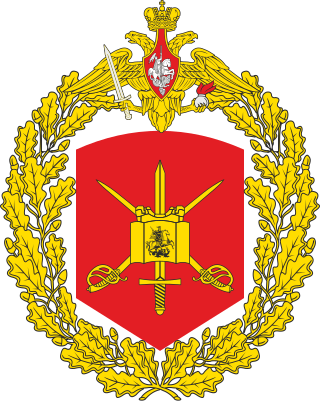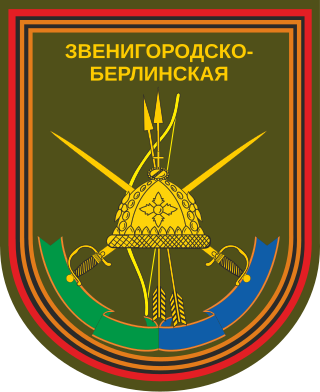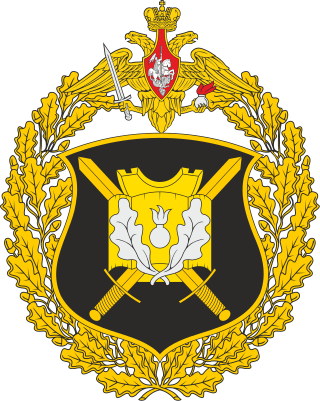Related Research Articles

The 29th Infantry Division, also known as the "Blue and Gray Division", is an infantry division of the United States Army based at Fort Belvoir in Fairfax County, Virginia. The division is currently a formation of the Army National Guard and includes units from Virginia, Maryland, Kentucky, North Carolina, South Carolina, and West Virginia.

The 35th Infantry Division, formerly known as the 35th Division, is an infantry formation of the United States Army National Guard headquartered at Fort Leavenworth, Kansas.

The 42nd Infantry Division (42ID) ("Rainbow") is a division of the United States Army National Guard. It was nicknamed the Rainbow Division because, during rapid mobilization for service in WW1, it was formed from 27 National Guard units from across the US. The division was engaged in four major operations between July 1918 and the armistice in November 1918, and demobilized in 1919. Since World War I, the 42nd Infantry Division has served in World War II and the Global War on Terrorism (GWOT).

The 34th Infantry Division is an infantry division of the United States Army, part of the National Guard, that participated in World War I, World War II and multiple current conflicts. It was the first American division deployed to Europe in World War II, where it fought with great distinction in the Italian Campaign.

The 1st Guards Tank Red Banner Army is a tank army of the Russian Ground Forces.

The Oregon Army National Guard is a federally mandated and equipped military organization under the civilian direction of the Oregon Military Department, with the Governor of Oregon as its Commander-in-Chief. It responds to state and national emergencies, military conflicts and natural disasters, and conducts search and rescue operations. While the history of the militia dates back to the establishment of the first Oregon militia in 1843, the present Guard was not established until after 1903. The modern Guard includes citizen soldiers, and its motto is "When we are needed, we are there."

The Virginia National Guard is part of the National Guard of the United States, a dual federal-state military reserve force. It consists of the Virginia Army National Guard and Virginia Air National Guard.. The National Guard may be called into federal service in response to a call by the President of the United States in accordance with Title 10 of the United States Code.

The 2nd Guards Tatsinskaya Tank Corps was a tank corps of the Soviet Union's Red Army that saw service during World War II on the Eastern Front of Europe. The unit's most notable moment was in the raid on Tatsinskaya during Operation Little Saturn in World War II. After the war, it continued to serve with the Soviet occupation forces in Central Europe. It was originally the 24th Tank Corps. The formation had approximately the same size and combat power as a Wehrmacht Panzer Division, and less than a British Armoured Division had during World War II.

The SO-152, usually known by its GRAU designation 2S3, is a Soviet 152.4 mm self-propelled gun developed in 1968, as a response to the American 155 mm M109 howitzer. Development began in 1967, according to the Resolution of the Council of Ministers of the Soviet Union from July 4, 1967. In 1968, the SO-152 was completed and in 1971 entered service. The fighting vehicle also received the added designation Akatsiya (Акация), which is Russian for Acacia.

The 74th Guards Motor Rifle Brigade is a military formation of the Russian Ground Forces's 41st Combined Arms Army, part of the Central Military District, stationed in Yurga, Kemerovo Oblast, Russia. Military Unit в/ч 21005.

The 4th Guards Tank Division is a Guards armoured division of the Russian Ground Forces. The division is named after Yuri Andropov.

The 20th Guards Carpathian-Berlin Motor Rifle Division is a formation of the Russian Ground Forces, originally formed within the Soviet Red Army as the 3rd Mechanised Corps. The division was reformed in 2021 from the former 20th Guards Motor Rifle Brigade.

The 98th Guards Airborne Division is an airborne division of the Russian Airborne Troops, currently based in Ivanovo.

The 7th Guards Mountain Air Assault Division is the only elite guards division of the Russian Airborne Forces (VDV) responsible for mountain warfare and jungle warfare.

The 103rd Separate Guards Airborne Brigade is an airborne brigade of the Belarusian Special Forces. Its predecessor unit was the 103rd Guards Airborne Division, which was a division of the Soviet Airborne Troops. It was established in 1946 and disbanded in 1993, a year after its transfer to the Armed Forces of Belarus. The division was formed from the 103rd Guards Rifle Division, which fought as infantry during the final months of World War II in the Vienna Offensive following its formation in late 1944.

The 51st Guards Artillery Brigade is an artillery brigade of the Belarusian Ground Forces, based at Osipovichi.
The 17th Guards Rifle Division was an infantry division of the Red Army during World War II. It was created on March 17, 1942, from the first formation of the 119th Rifle Division, in recognition of that division's stalwart defense against German Army Group Center in the Battle of Moscow, and in the subsequent strategic offensive that threw the German forces back from the capital. It became the 123rd Guards Motor Rifle Division in 1957 and converted into the 129th Guards Machine-Gun Artillery Division in 1989. In 2001, it was converted to the 17th Guards Motor Rifle Division and became the 70th Guards Motor Rifle Brigade in 2009. The brigade was reorganized as the 114th Guards Motor Rifle Regiment of the reformed 127th Motor Rifle Division in 2018. The regiment is currently based in Ussuriysk.

The 3rd Guards Anti-Aircraft Artillery Division was an anti-aircraft artillery division of the Soviet Union's Red Army during World War II and the Soviet Army during the early years of the Cold War.
The 23rd Guards Rifle Division was reformed as an elite infantry division of the Red Army in March, 1942, based on the 1st formation of the 88th Rifle Division, and served in that role until after the end of the Great Patriotic War. It was one of just two Guards divisions to be formed in the far north, the 10th Guards being the other. It continued to serve in Karelian Front, where it was formed, until October when it was railed south to join the 1st Shock Army of Northwestern Front; it would remain in that Army until nearly the end of 1944. Over the next several months it took part in the dismal fighting around the Demyansk salient until it was evacuated by the German II Army Corps in March, 1943. During the rest of the year the division continued battling through the forests and swamps south of Lake Ilmen, occasionally under command of the 14th Guards Rifle Corps, until the Leningrad-Novgorod Offensive began in late January, 1944. The 23rd Guards took part in the liberation of Staraya Russa in mid-February and went on to win a battle honor about a week later at Dno. 1st Shock Army closed up to the German Panther Line south of Lake Peipus during the spring and then helped break through it at the start of the Baltic Campaign in July. For its part in the liberation of Ostrov the division was awarded the Order of the Red Banner before gradually advancing through Latvia towards Riga, which it helped to liberate in October. By now it was in the 12th Guards Rifle Corps which was transferred in late November to the 3rd Shock Army in 1st Belorussian Front. The 23rd Guards would remain under these commands for the duration of the war, advancing across Poland and eastern Germany into Berlin in 1945 and winning a second honorific after the fighting ended. Despite a fine record of service it was disbanded in 1947.
The 73rd Guards Rifle Division was reformed as an elite infantry division of the Red Army in March 1943, based on the 2nd formation of the 38th Rifle Division, and served in that role until after the end of the Great Patriotic War.
References
- ↑ "Detailseite - Archivportal-D". www.archivportal-d.de. Archived from the original on 2022-12-10. Retrieved 2022-12-10.